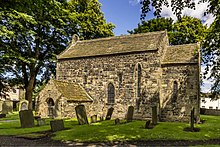Anglo-Saxon architecture
The Anglo-Saxon architecture was a period of architectural history in England and parts of Wales , which extends from the middle of the 5th century to the Norman Conquest of England stretched in 1066th
Development (7th century to 1066)
The Anglo-Saxon architecture is the first phase in the development of medieval English architecture. Whether and to what extent it is based on Roman architecture is ultimately an unanswered question. The Romans had left England in 410. It is difficult to reconstruct what the architecture looked like in the following centuries, because there are hardly any data from the period between the Roman era and the beginning of the 7th century. Added to this is the fact that due to the raids of the Vikings and Danes from the late 8th century from the period between 750 and about 870 almost no structures have survived.
Angling , Saxons and Jutes invaded England from the mainland from the middle of the 5th century . They formed seven Anglo-Saxon minor kingdoms: Kent , Sussex , Essex , Wessex , East Anglia , Mercia and Northumbria . The Benedictine monk Augustine of Canterbury († around 605) was born in 596 by Pope Gregory the Elder. Size charged with the mission of England. Christianity in its religious Roman form first gained a foothold in Kent, where Augustine was ordained Archbishop of Canterbury in 601 . Canterbury continued to be the ecclesiastical center of England.
Since the 9th century, the Anglo-Saxons had been exposed to strong influences from the Danes, who had gained a foothold in England and ruled the country from 1016 to 1042. In 1042, however, the national kingship was able to take the lead again with Edward the Confessor . This period ended with the Norman conquest in 1066 after the Battle of Hastings .
Basic forms of architecture
The Anglo-Saxon architecture extends over the period from approx. 600 to 1066. The Anglo-Saxon church buildings can basically be divided into two large groups:
- The apses are characteristic of the southeast group
- The hallmarks of the northern group are straight choir closures (the only exception is the church of Hexham , which has an apse)
The churches of the northern group also show that the central nave is mostly more than three times as long as it is wide, while in the southern group it is only 1½ to 1¾ times as long as it is wide.
More detailed provisions on Anglo-Saxon church construction can only be given with caution, firstly because only a few churches have been preserved at least to the extent that their floor plan can be clearly determined, and secondly because, despite almost identical floor plans, the elevation of the respective churches can be completely different. Thirdly, it is true of the larger churches that they received their present form only after many structural changes over the centuries. Only some of the smaller churches still have their original shape.
In the Anglo-Saxon period, the ceilings of all the surviving churches are likely to have been made of wood and some of them painted; open roof trusses were also possible. The facades of the mighty stone towers imitated the basic forms of the wooden construction (especially Earls Barton , 10th to early 11th century), whole churches were built of wood ( Greensted Church in Essex, approx. 1013). During this time, the English master builders showed a clear tendency towards decoration, which in later phases developed into a defining moment and especially in vault construction to a unique mastery.
See also
literature
- HJ Böker: English sacred architecture of the Middle Ages. Darmstadt 1984.
- B. Cherry: Ecclesiastical architecture. In: The Archeology of Anglo-Saxon England. London 1976, pp. 151-200.
- GH Cook: The English Cathedrals through the Centuries . London 1957.
- K. Escher: English cathedrals . Zurich 1929.
- E. Fernie: The Architecture of the Anglo-Saxons . Holmes & Meier, New York 1983.
- EA Fisher: An Introduction to Anglo-Saxon Architecture and Sculpture . London 1959.
- G. Hutton, E. Smith: English Parish Churches . London 1953.
- Nikolaus Pevsner, John Fleming, Hugh Honor: Lexicon of World Architecture . Prestel, Munich 1971, pp. 217-218.
- HM Taylor, J. Taylor: Anglo-Saxon Architecture . Volumes 1 and 2, Cambridge 1965; Volume 3, Cambridge / London / New York / Melbourne 1978.
- G. Webb: Architecture in Britain. The Middle Ages (= Pelican History of Art . Z 12). London 1956.

